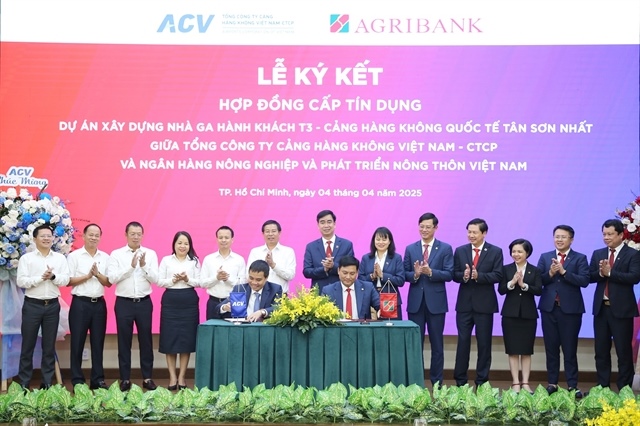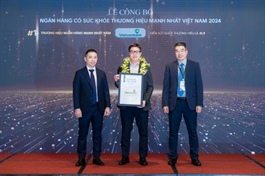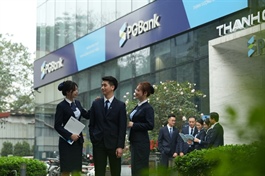Banks ramp up infrastructure lending amid growth ambitions and credit risks
Banks ramp up infrastructure lending amid growth ambitions and credit risks
Vietnamese banks are injecting trillions of đồng into strategic infrastructure projects to support the country’s ambitious growth targets, though experts caution that the credit expansion brings underlying risks requiring clearer regulation and stronger fiscal discipline.

The signing ceremony of the credit contract for the “Construction of Passenger Terminal T3 – Tân Sơn Nhất International Airport” project between Agribank and ACV. — Photo courtesy of Agribank |
A surge in large-scale credit agreements has underscored the increasing role of commercial banks in financing Việt Nam’s infrastructure sector, as the Government intensifies efforts to stimulate economic growth through public investment.
However, economists caution that alongside great potential, infrastructure lending carries inherent risks that necessitate clearer and more consistent regulatory frameworks.
Late last week, Agribank signed a major credit agreement with the Airports Corporation of Việt Nam (ACV), formalising a loan contract for the 'Construction of Passenger Terminal T3 – Tân Sơn Nhất International Airport' project, with a total investment of over VNĐ10 trillion (US$387.5 million).
Earlier, Vietcombank extended VNĐ5.4 trillion (US$208.7 million) in loans for the 500kV Lào Cai–Vĩnh Yên transmission line project, while TPBank disbursed VNĐ2.5 trillion for the Hữu Nghị–Chi Lăng expressway under the Build Operate Transfer (BOT) model.
According to sources from baodautu.vn, an unprecedented credit package worth hundreds of trillions of đồng is being prepared for disbursement to strategic infrastructure projects — the largest credit initiative of its kind in the country’s history.
Lê Xuân Nghĩa, a leading economist, remarked that in the context of growing export challenges caused by newly imposed US tariffs, infrastructure investment is the most rational and urgent lever to achieve Việt Nam’s ambitious GDP growth target of over eight per cent in 2025.
He forecasted that from late 2025 onwards, large-scale infrastructure projects with annual capital requirements of $8–10 billion will be rolled out, with the banking system expected to play a pivotal role in financing alongside the State budget.
PPP model opens up credit channels
Historically, infrastructure lending — especially to BOT and BT projects — has been considered high risk due to long payback periods, posing balance sheet risks for banks reliant on short-term deposits.
Between 2011 and 2015, banks rushed to finance BOT and BT ventures, many of which later ran into regulatory roadblocks, cost overruns and financial losses. As a result, BOT and BT loan portfolios have since shrunk to under one per cent of the total outstanding credit.
Chief Economist and Head of SSI Research, Nguyễn Lưu Hưng, noted that public investment frameworks have since improved. Projects now operate under the public-private partnership (PPP) model, where the State contributes up to 50 per cent of funding, banks around 35 per cent and enterprises the remaining 15 per cent. Administrative procedures have also been streamlined, with faster disbursement and reimbursement timelines making such investments more attractive to banks.
Nonetheless, representatives of the State Bank of Việt Nam (SBV) have underscored the structural mismatch between the long payback nature of infrastructure projects and the short-term nature of bank deposits. Large-scale projects often require capital in the trillions of đồng, while banks operate under credit growth limits, creating a bottleneck for further lending.
The Chairman of Vietcombank, Nguyễn Thanh Tùng, noted that many upcoming strategic projects are expected to be assigned to State-owned corporations, many of whom have already reached their regulatory lending limits. Without special provisions, banks may not be able to extend additional credit to these entities.
To address these concerns, Đỗ Minh Phú, Chairman of DOJI Group, proposed that the SBV exempt BOT loans from credit growth ceilings, to enable banks to support national projects more effectively.
In response, an SBV representative confirmed that a proposal is being submitted to the Prime Minister to allow credit growth limits to be lifted for critical infrastructure projects, while stressing the importance of a well-defined and unified regulatory framework to avoid past pitfalls.
To mitigate risks, the Ministry of Construction has submitted a proposal to the Government and National Assembly to allocate VNĐ14.8 trillion for repurchasing and restructuring failed BOT projects approved before 2015.

The signing ceremony of the credit contract for the “Construction of Passenger Terminal T3 – Tân Sơn Nhất International Airport” project between Agribank and ACV. — Photo courtesy of Agribank |
Prime Minister Phạm Minh Chính has also directed the banking sector to actively support strategic infrastructure development, urging agencies to resolve bottlenecks with the mindset that: “No difficulty is insurmountable.”
In 2025, the Ministry of Transport plans to initiate 19 new projects and complete 50 others, while preparing key developments such as the HCM City–Chơn Thành expressway, Cam Lộ–La Sơn, and the North–South high-speed railway.
Experts emphasise that to sustain momentum, unresolved financial issues must be addressed and a balanced legal framework introduced to protect the interests of the State, private investors and banks involved in project financing.
Prudent planning and transparent, consistent policies will be critical to ensure that the influx of infrastructure credit becomes a sustainable engine for economic growth, rather than a repeat of past policy missteps.
- 08:23 24/04/2025





























